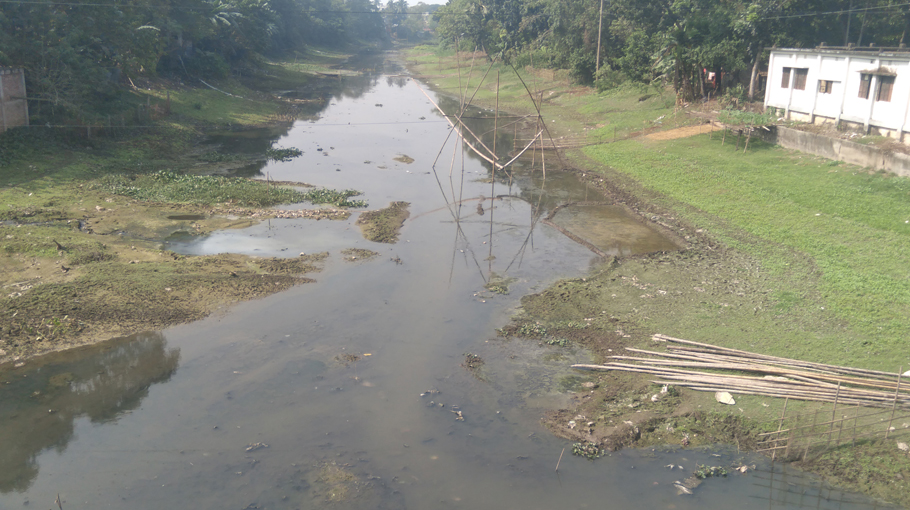Actions needed to revive Baral River


The once mighty Baral River is now almost empty. This river is facing a slow death. In order to restore the river, to make the river greener, to free it from pollution, the people of Chatmohar have already formed a human chain over an area of about 200 km. People in the area held more than hundreds of meetings, rallies, human chains, processions, discussion meetings, exchange of views, seminars, and press conferences at different times since 2006. Despite some achievements, the river has not returned to its normal state.
At present, the place of origin of Baral River has become dehydrated. At the source of the river (Charghat) no water is flowing from the Padma River. The water flow of Baral along with Padma has stopped due to the rise of multiple sand banks. Occupiers have built houses by occupying Baral river in many places. During the dry season, many farmers cultivate various crops including paddy, wheat, pulses, sugarcane, lentil and mustard along the river. For some years, some parts of Baral have not been flooded at all. In some parts, Baral water enters during the monsoon season, but in the dry season, it becomes almost empty. Irrigation work is hampered as the river becomes almost waterless during the dry season. Which has a negative impact on later crop production. Moreover, the people live adjacent to the river are also deprived of other benefits of water.
Read more: River gypsies in existential crisis
It has been found out that the tributary of the Padma River is Baral River. It flows through the ten upazilas of Charghat, Bagha, Bagatipara of Natore, Baraigram, Gurudaspur, Chatmohar, Pabna, Bhangura, Faridpur, Sathia and Shahjadpur of Sirajganj and joins the Jamuna River at Sirajganj. Mizanur Rahman, member secretary of the National Committee for the Protection of the Baral River, said that the river has divided into two parts after flowing from Charghat to Atghari. One part has been divided into two parts at the eastern boundary of Chatmohar under the name of Gumani, which joins the Atrai River through Nazirpur under Chanchkair area of Gurudaspur under the Ahmedpur Bridge. One part has merged with Baral in Nurnagar. The other part goes to Sonahara area after Ashtamanisha and merges with Baral River again called Baral, flows to Baghabari area and merges with Hurasagar River and finally merges with Jamuna. Although there is a lot of water from Dahapara to Hurasagar in monsoon season, there is little water in dry season. During the monsoon season, the water of the Padma enters an area of 48 km from Charghat-Wizgate to Atghari-Wiz Gate, but the water does not enter the river through Charghat-Wizgate for about six months of the year. From Atghari, a part of Baral has gone to Bonpara of Natore. The length of this part is 18 kilometers. Occupiers have occupied almost all of these 16 kilometers. Housing societies, shelter projects and even government offices have been built by filling the river. It is understood that there is no sign of river in this 16 km area.
It is learned that in order to restore navigability and maintain normal flow of Padma water in Baral, a project worth Tk 130 million was spent on digging 1800 meters and 19 kilometers of river at the entrance from Charghat-Vizgate to Padma. Excavation of the intake channel of Charghat Baral River was completed in February 2010. Although the intake channel was excavated, Baral's good days did not return. This time the source of Baral became dehydrated in the month of Kartik.
Regarding the acquisition, Mizanur Rahman said that Charghat Wizgate was closed for about 30 years. As a result of our movement, the widget gate has been opened. The source of the river has been excavated 1600 meters. Four landscaping cross dams at Ramnagar, Bonthar, Dahapara and Natun Bazar Kheyaghat in Chatmohar have been removed. Attempts were made a few years ago to build another dam along the river at the Jardis junction in Chatmohar; As a result of the movement, a bridge was built there instead of a dam. Earlier, the Rivers Task Force sought a recommendation from Minister AKM Mozammel Haque as Chairman of the Baral Rivers Task Force on Baral Rivers. AKM Mozammel Haque recommended six points including removal of all obstructions in the river, release of occupants and excavation. On behalf of the Ministry of Water Resources, the Water Development Board took over the responsibility of monitoring the issue. However, they want to keep the gate of Charghat.
Read more: ‘People of northern region will be protected from river erosion’
Besides, 56 structures (bridges, culverts) from Charghat to Bagha will have to be demolished and enlarged. The river should be revived by marking the boundaries of the river and removing all illegal structures in the middle of the river. The soil of the river has to be removed elsewhere by digging. In order to save the agro sector and fishing sector of Chatmohar region, immediate steps are needed to revive the Baral River.



